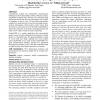Free Online Productivity Tools
i2Speak
i2Symbol
i2OCR
iTex2Img
iWeb2Print
iWeb2Shot
i2Type
iPdf2Split
iPdf2Merge
i2Bopomofo
i2Arabic
i2Style
i2Image
i2PDF
iLatex2Rtf
Sci2ools
CSCW
2011
ACM
2011
ACM
CoupleVIBE: mobile implicit communication to improve awareness for (long-distance) couples
Long-distance couples face considerable communication challenges in their relationships. Unlike collocated couples, long-distance couples lack awareness cues associated with physical proximity and must use technologies such as SMS or telephony to stay in sync. We posit that long-distance couples have needs that are not met by prevailing communication technologies, which require explicit action from the sender as well as the receiver. We built CoupleVIBE to explore the properties of an implicit messaging channel and observe how couples would use such a technology. CoupleVIBE is a mobile application that automatically pushes a user’s location-information to her partner’s mobile phone via vibrotactile cues. We present qualitative results of a four-week user study, studying how seven couples used CoupleVIBE. A key result is that CoupleVIBE’s implicit communication modality operated as a foundation that helps keep couples in sync, with other modalities being brought into play when fu...
Considerable Communication Challenges | Couples | CSCW 2011 | Long-distance Couples | Social Sciences |
| Added | 13 May 2011 |
| Updated | 13 May 2011 |
| Type | Journal |
| Year | 2011 |
| Where | CSCW |
| Authors | Elizabeth Bales, Kevin A. Li, William Griwsold |
Comments (0)

